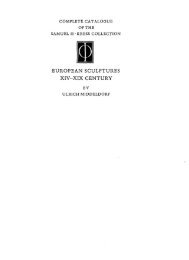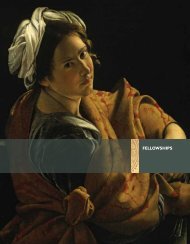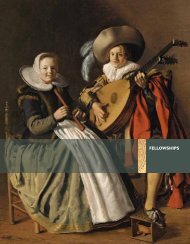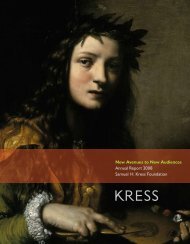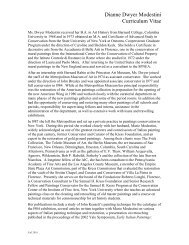The Campus Art Museum - Samuel H. Kress Foundation
The Campus Art Museum - Samuel H. Kress Foundation
The Campus Art Museum - Samuel H. Kress Foundation
Create successful ePaper yourself
Turn your PDF publications into a flip-book with our unique Google optimized e-Paper software.
What difference does having an art museum make beyond contribution to<br />
research and academics? Three main effects of the museum on participants’ lives<br />
emerge from the interviews. It can influence:<br />
• decisions to come to that particular college/university<br />
• decisions about future studies, careers, or avocations, and<br />
• perspectives of oneself as well as of the college or university<br />
For some, the campus art museum was a deciding factor in their decision to<br />
attend a particular school as a student or to accept a position as faculty. Following<br />
are quotes from both a student and a faculty member talking about the role of the<br />
Snite in their attraction to Notre Dame:<br />
Actually I had never visited the art department before I was accepted. I came<br />
here for conferences related to art… and I came to the Snite on both occasions<br />
because I usually gravitate towards museums wherever I go. I was incredibly<br />
impressed with the collection. I was just expecting it to be very small and<br />
unimpressive—university museums don’t have to be that large, so when I saw<br />
it, I was very impressed. So when I was accepted, that was definitely something<br />
that factored into my decision. (student)<br />
I was aware of the <strong>Museum</strong> when I came here because of the pre-Columbian<br />
collection. That really interested me…. I was actually kind of blown away when<br />
I first came here and saw it. Part of the interview was to visit the museum—it<br />
was part of everything the university could offer. (professor)<br />
Might they have come if the campus had no art museum? <strong>Art</strong> history<br />
professors at several institutions said that since faculty positions are difficult to find,<br />
they would have gone somewhere without a museum, if that were the only choice<br />
available, but that they are happy to be at schools with museums with extensive<br />
collections. Students, however, have more choices about which institution to attend<br />
and those who already have an interest in art history, museum studies, or arts in<br />
general are likely to opt, if they can, for a school with a good art museum.<br />
<strong>The</strong> possible influence of the art museum on helping to decide a student’s career<br />
is significant. One student stated, “I probably wouldn’t have realized I wanted to<br />
have a career in the arts if it hadn’t been for the museum. It has helped me discover<br />
what I want to do. I really appreciate this museum.” Others made similar comments.<br />
This influence most often comes through the opportunity for students to work at<br />
the museum. Some students who begin their studies planning to become an art<br />
history professor or studio artist discover, through a job at the museum, that they<br />
want to work in the future with art museums. Some students from disciplines<br />
outside the visual arts learn through their work at the museum that they want to<br />
pursue museum studies. Some students from across the disciplines who have the<br />
opportunity to be docents for public school groups, like those in education who<br />
work with children through museum education programs, find that they want to<br />
continue working with museum education in some way. At Oberlin, for example,<br />
I talked with a group of six art history students who are also docents at the<br />
What Difference Can A <strong>Campus</strong> <strong>Art</strong> <strong>Museum</strong> Make?<br />
18



